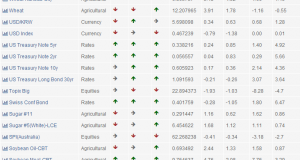This has been a choppy year for diversified futures traders and with only one month left on the year we only have a little over two percent to show for it. On the other hand, the traditional approach of buying and holding global equities would have lost close to ten percent this year and at substantial volatility. Overall this is a disappointing for diversified futures trading but these years are part of the game and the cost of doing business in this field.
After the lows in the summer the long rates and short equity positions propelled the core strategy to new highs which were maintained up until early October when the strategy saw one of the worst months in the past decade. This was a really bad month for most CTA funds and some of the funds which has been in the business for many decades saw their worst months ever. The reversal in fortune in October was caused by the two interrelated factors of dollar and agricultural commodities. The strategy had recently build up substantial bets on long dollar as well as on short agricultural commodities and as both of these sectors turned violently against the trend in the first week of October losses were taken on all sides. There are speculations of whether the MF Global situation had anything to do with this large price action but it is impossible to answer with certainty.
As always, the data presented for the strategies on this site assume 20 dollar round turn cost per trade, realistic market specific slippage, 1.5% management fee, 0.5% misc fixed cost and 15% performance fee.
 The competition had a bad month as well as can be seen, all but global equities, represented by MSCI World, which made a rebound move. Over time the equity indexes have never been able to stand up to diversified futures although in the short run anything is possible.
The competition had a bad month as well as can be seen, all but global equities, represented by MSCI World, which made a rebound move. Over time the equity indexes have never been able to stand up to diversified futures although in the short run anything is possible.
 Following the Trend
Following the Trend



